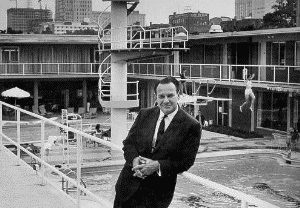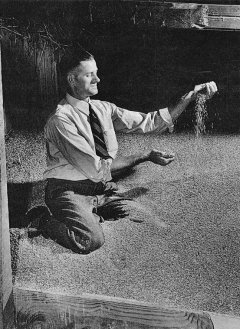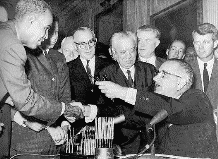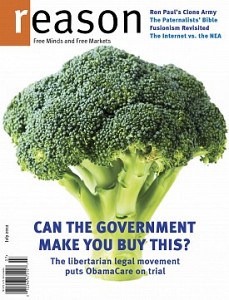|
The
powers of Congress are enumerated in several
places in the Constitution. The most
important listing of congressional powers appears
in Article I, Section 8. THE COMMERCE POWER The next series of cases illustrate two divergent approaches to analyzing whether an activity is reachable under the commerce power. In U. S. vs E. C. Knight the Court concluded that the Congress lacked the power to reach a monopoly in the "manufacture" of refined sugar, but could reach a "monopoly of commerce" involving sugar. The Knight case illustrates the formal (or "categorical") approach to analyzing the reach of the commerce power. The formal approach focuses on such questions as whether the regulated activitity is "in" or "outside" the stream of commerce, whether the activity is "local" or "interstate," or whether the effects of the activity on interstate commerce are "direct" or "indirect." The contrasting empirical approach, illustrated by Houston E. & W. Ry. Co. vs U. S., looks to the magnitude of the effect that the regulated activity has on interstate commerce, without special regard to how the activity is categorized. In Houston, the Court upheld a federal agency's regulation of freight rates on travel wholly within Texas because the freight transporation within Texas was found to be substantially affecting interstate commerce. Hammer vs Dagenhart (1918) considered the constitutionality of the Child Labor Act, which banned items produced by child labor from interstate commerce. Adopting the formal approach, the Court saw the Act as unconstitutional attempt to regulate a purely local matter, workplace conditions. The harm of child labor, the Court concluded, had nothing to do with interstate commerce and thus fell outside the reach of congressional power.
N.L.R. B. vs Jones (1937) represented an important turning point in the Court's Commerce Clause jurisprudence. The year before, in a case called Carter vs Carter Coal Co., the Court had invalidated a New Deal program that attempted to regulate the wage and hour practices of coal companies on the ground that such practices were "local" and had only an "indirect" effect on interstate commerce. Enraged by the Court's decision in Carter and other cases, President Roosevelt proposed "packing the Court" with sympathetic justices by increasing its size from nine to fifteen. In N.L.R. B. vs Jones, Chief Justice Hughes and Justice Roberts side with the government in voting to uphold an N.L.R.B. action ordering the reinstatement of union organizing employees protected by federal law at a Pennsylvania steel plant--the "switch in time that saved nine." Over the objections of four dissenting justices who called the interstate effects of the regulated activity "too indirect," the Court concluded that the steel industry is an interstate web of activities stretching from the iron mines of Minnesota to the steel plants of Pennsylvania and thus the manufacturing of steel is properly reachable under the Commerce Clause. U.
S. vs Darby (1941), in unanimously
overruling Hammer vs Dagenhart,
demonstrated how much the Court had changed its
approach to Commerce Clause in a generation.
Using a "substantial effects" test, the Court
upheld the Fair Labor Standards Act--an important
piece of legislation that effectively set national
minimum wage and maximum hour laws by prohibiting
the interstate shipment of goods manufactured in
violation of the federal standards.
Once
having established that congressional exercises of
power were valid if shown to regulate activities
"substantially affecting" interstate commerce, the
Court proceeded to open up more opportunities for
exercise of the commerce power by holding that an
activity only trivially affecting interstate
commerce might nonetheless by regulated if all of
the regulated activities of various
individuals--taken cumulatively--had substantial
interstate effects. In Wickard vs
Filburn (1942), for example, the Court
upheld a $117 penalty imposed on a Ohio farmer for
growing wheat on 12 more acres than he was
permitted to under the Agricultural Adjustment
Act. The Court relied on Wickard in
the 2005 case of Gonzales v Raich, upholding the
power of Congress to authorized seizure of
doctor-prescribed marijuana allowed under the laws
of California and other states. The Court in
Gonzales noted
that local use of medical marijuana had a
cumulative effect on the black market for
marijuana.
The
cumulative effects test also convinced the Court
to uphold provisions of the 1964 Civil Rights Act
that required the 216-room Heart of Atlanta Motel
to rent its rooms to persons regardless of race (Heart
of Atlanta vs U. S.) and outlawed
racial discrimination at small restaurants such as
Ollie's Bar-B-Q in Birmingham (Katzenbach vs
McClung). In 1971, legislation making
loansharking a federal crime was upheld on a
similar basis (Perez vs U. S.) . The Heart
of Atlanta, McClung, and Perez cases
led to speculation that perhaps any activity might
be regulated under a loose application of the
cumulative effects test.
 Moreton Rolleston Jr., owner of the Heart of Atlanta motel (photo: Wayne Wilson/Leviton-Atlanta) In
1995, however, the Supreme Court--for the first
time in more than half a century--invalidated a
federal law on the ground that it was outside the
scope of the commerce power. In U. S. vs
Lopez the Court, by a 5 to 4 vote, found
unconstitutional a provision of the Gun-Free
School Zone Act that made it a federal crime to
possess a gun (even one that never traveled across
state lines) within a thousand feet of a school
ground. It was unclear whether the
government lost because the Congress failed to
make adequate factual findings about the
impact of school gun violence on interstate
commerce or whether the Court was convinced that
the interstate impact of possessing guns near
schools had only an insignificant effect on
interstate commerce. The four dissenters
argued that it was sufficient for the Congress to
show it had a rational basis for finding a
significant effect on interstate commerce.
In U.
S. vs Morrison (2000) the Court considered a
suit brought by a former student of Virginia
Poytechnic Institute who alleged she was raped by
two university football players. The
defendant players and university argued that the
Violence Against Women Act, which allowed victims
of gender- motivated violence to bring federal
civil suits for damages, was outside of the scope
of the commerce power. The Court agreed with
the defendants, even though in this case Congress
had made specific findings that gender-motivated
violence deterred interstate travel, diminished
national productivity, and increased medical
costs. The Court concluded that upholding
the Violence Against Women Act would open the door
to a federalization of virtually all serious
crime--as well as family law and other areas of
traditional state regulation. The Court said
that Congress must distinguish between "what is
truly national and what is truly local"--and that
its power under the Commerce Clause reaches only
the former. In a concurring opinion, Justice
Thomas went even further, urging abandonment of
"the substantial effects" test. In the
closely watched case of National Federation of Independent
Business v Sebelius(2012), the Court
considered whether the Affordable Care Act of
2010, the Obama Administration's signature piece
of legislation was constitutional. The
Court, on a 5 to 4 vote, found that the individual
mandate provision of the Act, which required all
persons to buy health insurance or pay a penalty,
was outside of Congress's powers under the
Commerce Clause. (The individual mandate,
also on a 5 to 4 vote, survived, however, as a
valid exercise of Congress's taxing power.)
Chief Justice Roberts concluded that the Commerce
Clause gave Congress no power to regulate
inactivity (here, the decision of an individual
not to buy health insurance.) To allow such
a power, Roberts argued, would give almost
limitless power to Congress because there are "an
infinite number" of things people do not do
everyday. Congress might even, Roberts
wrote, order people to buy broccoli. The
four dissenters (Ginsburg, Sotomayor, Breyer, and
Kagan) dissented on the Commerce Clause question,
accusing the majority of returning to the
categorical approach that had properly been long
abandoned by the Court. In the view of the
dissenters, the failure of healthy individuals to
buy health insurance had obvious and substantial
effects on the health care market, which
represents almost one sixth of the U.S.
economy. The dissenters argued that
precedents such as Wickard v Filburn supported the
exercise of power. |
Questions COMMERCE CLAUSE QUESTIONS 2. The Constitution gives Congress the power to regulate commerce "among" the several states. Does that mean "between" the states, or could it also mean "among the people"--that is, even within a state? 3. What would have been the economic future of the United States if Gibbons had gone the other way? 4. Which of the two basic approaches to Commerce Clause analysis is better, the "empirical test" (e.g., "substantial effects") or the categorical approach that seeks to label effects as "direct" or "indirect" or activities as "local" or "national." What are the advantages and disadvantages of each approach? 5. Does the power to "regulate" commerce include the power to ban outright certain articles of commerce--such as lottery tickets, firecrackers, hand grenades, or marijuana? 12. Is taking a woman across state lines for immoral purposes "commerce"? (The Court thought so in a decision upholding the constitutionality of the Mann Act.) 6. Should the Court examine the motive of Congress in enacting legislation under its commerce power, or just analyze the connection of the regulation to interstate effects? In Hammer vs Dagenhart, the Court was influenced by its conclusion that Congress really legislated because it disapproved of child labor, rather than out of any genuine concern for how child labor was affecting the national economy or the dangers posed by articles produced by child labor. Should the motive of Congress been a factor? 7. N.L.R.B. vs Jones, along with U. S. vs Lopez years later, is generally considered one of the two key turning points in Commerce Clause jurisprudence. What makes it so? 8. Does the "cumulative effects" approach of Wickard represent a major expansion of the "substantial effects" test as employed previously? 9. After McClung and Heart of Atlanta Motel, could you imagine any eating establishment or motel that would be outside the reach of Congress's power under the Commerce Clause to enact civil rights laws prohibiting discrimination against patrons or guests? 10. Lopez and Morrison raise serious questions about the ability of Congress to enact laws providing federal punishment or federal remedies for conduct traditionally regulated under state criminal codes. Which of the following are likely to be upheld?: (1) a law making "carjacking" a federal crime? (2) a law making "drive-by shootings" a federal crime? (3) a law making it a federal crime to carry out any action designed to terrorize? (4) a law making child molestation a federal crime? (5) a law making child pornography a federal crime? 11. How does Congress distinguish, as Morrison requires it to do, between "what is truly national and what is truly local."? 12. National Federation of Independent Business draws a line between commercial activity, which Congress can regulate, and inactivity, which it cannot. Many economists argue that any example of inactivity can be re-described as another sort of activity, but Justice Roberts says the Framers were practical men, not students of metaphysics, and would have appreciated the difference. Do you think he is right? 13. The dissenters suggest that the inactivity/activity line is just a return to the discredited categorical approaches of the past, and that the Court should have focused on the impact that people without health insurance were having on the overall market. Will this categorical distinction last, and how much of a limitation will it prove to be on attempts by Congress to enact social welfare legislation?
|







